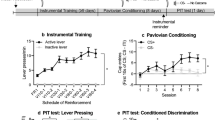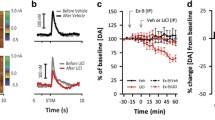Abstract
The effect of glutamate receptor antagonists on conditioned taste aversion (CTA) was studied in rats. The association of the short-term memory of a gustatory conditioned stimulus (CS) with visceral malaise (unconditioned stimulus, US) in the CTA paradigm takes place in the parabrachial nuclei (PBN) of the brainstem. The first direct evidence of participation of glutamatergic neurotransmission in the PBN during CTA demonstrated that the extracellular level of glutamate rises during saccharin drinking (Bielavska et al. in Brain Res 887:413–417, 2000). Our results show an effect of microdialysis administration of selective GluR antagonists into the PBN on the formation of CTA engram. We used four glutamate receptor (GluR) antagonists of different types (D-AP5, MK-801 as antagonists of ionotropic GluR and L-AP3, MSPG as antagonists of metabotropic GluR). The disruptive effect of MK-801 on CTA formation in the PBN is concentration-dependent, with the greatest inhibition under the higher concentrations eliciting significant disruption. The application of D-AP5 (0.1, 1, 5 mM) did not elicit a statistically significant blockade of CTA acquisition. This indicates that the association of the US–CS in the PBN is not dependent on NMDA receptors. On the contrary, application of L-AP3 (0.1, 1, 5 mM) blocked the CS–US association.





Similar content being viewed by others
References
Aguado L, delValle R, Perez L (1997) The NMDA-receptor antagonist ketamine as an unconditioned stimulus in taste aversion learning. Neurobiol Learn Mem 68:189–196
Bahar A, Dorfman N, Dudai Y (2004) Amygdalar circuits required for either consolidation or extinction of taste aversion memory are not required for reconsolidation. Eur J Neurosci 19:1115–1118
Behnisch T, Reymann KG (1993) Coactivation of metabotropic glutamate and N-methyl-d-aspartate receptors is involved in mechanisms of long-term potentiation maintenance in rat hippocampal Ca1 neurons. Neuroscience 54:37–47
Berman DE, Hazvi S, Neduva V, Dudai Y (2000) The role of identified neurotransmitter systems in the response of insular cortex to unfamiliar taste: activation of ERK1–2 and formation of a memory trace. J Neurosci 20:7017–7023
Bermudez-Rattoni F (2004) Molecular mechanisms of taste-recognition memory. Nat Rev Neurosci 5:209–217
Bielavska E, Bures J (1994) Universality of parabrachial mediation of conditioned taste-aversion. Behav Brain Res 60:35–42
Bielavska E, Krivanek J (1994) Intracerebral injection of polymyxin-B blocks the acquisition of conditioned taste-aversion in rats. Neurosci Lett 182:239–242
Bielavska E, Miksik I, Krivanek J (2000) Glutamate in the parabrachial nucleus of rats during conditioned taste aversion. Brain Res 887:413–417
Bills C, Schachtman TR, Serfozo P, Spooren WPJM, Gasparini F, Simonyi A (2005) Effects of metabotropic glutamate receptor 5 on latent inhibition in conditioned taste aversion. Behav Brain Res 157:71–78
Bures J, Bermúdez-Rattoni F, Yamamoto T (1998) Conditioned taste aversion. Memory of a special kind. Oxford University Press, Oxford
Castroalamancos MA, Donoghue JP, Connors BW (1995) Different forms of synaptic plasticity in somatosensory and motor areas of the neocortex. J Neurosci 15:5324–5333
Davis S, Butcher SP, Morris RGM (1992) The Nmda receptor antagonist D-2–amino-5-phosphonopentanoate (D-Ap5) impairs spatial-learning and Ltp in vivo at intracerebral concentrations comparable to those that block Ltp in vitro. J Neurosci 12:21–34
Escobar ML, Alcocer I, Chao V (1998) The NMDA receptor antagonist CPP impairs conditioned taste aversion and insular cortex long-term potentiation in vivo. Brain Res 812:246–251
Erdtsieckernste EBHW, Feenstra MGP, Botterblom MHA, Vanuum HFM, Sluiter AA, Heinsbroek RPW (1995) C-Fos expression in the rat-brain after pharmacological stimulation of the rat mediodorsal thalamus by means of microdialysis. Neuroscience 66:115–131
Fanselow MS, Kim JJ (1994) Acquisition of contextual pavlovian fear conditioning is blocked by application of an NMDA receptor antagonist d, l-2-amino-5-phosphonovaleric acid to the basolateral amygdala. Behav Neurosci 108:210–212
Ferreira G, Gutierrez R, De la Cruz V, Bermudez-Rattoni F (2002) Differential involvement of cortical muscarinic and NMDA receptors in short- and long-term taste aversion memory. Eur J Neurosci 16:1139–1145
Fifkova E, Marsala J (1967) Stereotaxic atlases for the cat, rabbit and rat. In: Bures J, Petran M, Zachar J (eds) Electrophysiological methods in biological research. Academic, New York
Guthmann A, Herbert H (1999) Distribution of metabotropic glutamate receptors in the parabrachial and Kolliker-fuse nuclei of the rat. Neuroscience 89:873–881
Gutierrez H, Gutierrez R, Ramirez-Trejo L, Silva-Gandarias R, Ormsby CE, Miranda MI, Bermudez-Rattoni F (1999a) Redundant basal forebrain modulation in taste aversion memory formation. J Neurosci 19:7661–7669
Gutierrez H, Hernandez-Echeagaray E, Ramirez-Amaya V, Bermudez-Rattoni F (1999b) Blockade of N-methyl-d-aspartate receptors in the insular cortex disrupts taste aversion and spatial memory formation. Neuroscience 89:751–758
Gutierrez R, Rodriguez-Ortiz CJ, De la Cruz V, Nunez-Jaramillo L, Bermudez-Rattoni F (2003) Cholinergic dependence of taste memory formation: evidence of two distinct processes. Neurobiol Learn Mem 80:323–331
Jackson A, Sanger DJ (1989) Conditioned taste-aversions induced by phencyclidine and other antagonists of N-methyl-d-aspartate. Neuropharmacology 28:459–464
Jane DE, Pittaway K, Sunter DC, Thomas NK, Watkins JC (1995) New phenylglycine derivatives with potent and selective antagonist activity at presynaptic glutamate receptors in neonatal rat spinal-cord. Neuropharmacology 34:851–856
Katz DB, Simon SA, Nicolelis MAL (2001) Dynamic and multimodal responses of gustatory cortical neurons in awake rats. J Neurosci 21:4478–4489
Kim M, McGaugh JL (1992) Effects of intraamygdala injections of Nmda receptor antagonists on acquisition and retention of inhibitory avoidance. Brain Res 585:35–48
Kolesarova D, Petrovicky P (1987) Parabrachial nuclear-complex in the rat (nuclei parabrachiales and nucleus Koelliker-fuse)—detailed cytoarchitectonic division and connections compared. J Hirnforsch 28:517–527
Krivanek J (1996) Conditioned taste aversion and protein kinase C in the parabrachial nucleus of rats. Neurobiol Learn Mem 65:154–162
Land CL, Riccio DC (1997) d-cycloserine, a positive modulator of the NMDA receptor, enhances acquisition of a conditioned taste aversion. Psychobiology 25:210–216
Madison DV, Malenka RC, Nicoll RA (1991) Mechanisms underlying long-term potentiation of synaptic transmission. Annu Rev Neurosci 14:379–397
Martin SJ, Grimwood PD, Morris RGM (2000) Synaptic plasticity and memory: an evaluation of the hypothesis. Annu Rev Neurosci 23:649–711
Masugi M, Yokoi M, Shigemoto R, Muguruma K, Watanabe Y, Sansig G, van der Putten H, Nakanishi S (1999) Metabotropic glutamate receptor subtype 7 ablation causes deficit in fear response and conditioned taste aversion. J Neurosci 19:955–963
Mickley GA, Remmers-Roeber DR, Crouse C, Peluso R (2000) Ketamine blocks a taste recognition memory in fetal rats. Pharmacol Biochem Behav 67:575–581
Miranda MI, Ferreira G, Ramirez-Lugo L, Bermudez-Rattoni F (2002) Glutamatergic activity in the amygdala signals visceral input during taste memory formation. Proc Natl Acad Sci USA 99:11417–11422
Miranda MI, McGaugh JL (2004) Enhancement of inhibitory avoidance and conditioned taste aversion memory with insular cortex infusions of 8-Br-cAMP: involvement of the basolateral amygdala. Learn Mem 11:312–317
Miranda MI, Ramirez-Lugo L, Bermudez-Rattoni F (2000) Cortical cholinergic activity is related to the novelty of the stimulus. Brain Res 882:230–235
Moron I, Ramirez-Lugo L, Ballesteros MA, Gutierrez R, Miranda MI, Gallo M, Bermudez-Rattoni F (2002) Differential effects of bicuculline and muscimol microinjections into the nucleus basalis magnocellularis in taste and place aversive memory formation. Behav Brain Res 134:425–431
Norgren R (1995) Gustatory pathways. In: Paxinos G (ed) The rat nervous system. Academic, San Diego, pp 751–771
Pfaffmann C, Frank M, Norgren R (1979) Neural mechanisms and behavioral aspects of taste. Annu Rev Psychol 30:283–325
Reilly S (1999) The parabrachial nucleus and conditioned taste aversion. Brain Res Bull 48:239–254
Riedel G, Reymann KG (1996) Metabotropic glutamate receptors in hippocampal long-term potentiation and learning and memory. Acta Physiol Scand 157:1–19
Rosenblum K, Berman DE, Hazvi S, Lamprecht R, Dudai Y (1997) NMDA receptor and the tyrosine phosphorylation of its 2B subunit in taste learning in the rat insular cortex. J Neurosci 17:5129–5135
Sacchetti B, Baldi E, Tassoni G, Bielavska E (2001) CAMKII inhibition in the parabrachial nuclei elicits conditioned taste aversion in rats. Neurobiol Learn Mem 75:253–261
Sacchetti B, Bielavska E (1998) Chelerythrine, a specific PKC inhibitor, blocks acquisition but not consolidation and retrieval of conditioned taste aversion in rat. Brain Res 799:84–90
Saugstad JA, Segerson TP, Westbrook GL (1995) l-2-amino-3-phosphonopropionic acid competitively antagonizes metabotropic glutamate receptor-1-alpha and receptor-5 in Xenopus Oocytes. Eur J Pharmacol Mol Pharmacol 289:395–397
Shigemoto R, Mizuno N (2000) Handbook of chemical neuroanatomy, vol 18. Elsevier, Amsterdam
Spray KJ, Bernstein IL (2004) Afferent and efferent connections of the parvicellular subdivision of iNTS: defining a circuit involved in taste aversion learning. Behav Brain Res 154:85–97
Tucci S, Rada P, Hernandez L (1998) Role of glutamate in the amygdala and lateral hypothalamus in conditioned taste aversion. Brain Res 813:44–49
Welzl H, Alessandri B, Battig K (1990) The formation of a new gustatory memory trace in rats is prevented by the noncompetitive Nmda antagonist ketamine. Psychobiology 18:43–47
Yamamoto T, Fujimoto Y (1991) Brain mechanisms of taste-aversion learning in the rat. Brain Res Bull 27:403–406
Yamamoto T (1998) Conditioned taste aversion. In: Bures J, Bermúdez-Rattoni F, Yamamoto T (eds) Memory of a special kind. Oxford, New York, pp 92–107
Yamamoto T, Fujimoto Y, Shimura T, Sakai N (1995) Conditioned taste-aversion in rats with excitotoxic brain-lesions. Neurosci Res 22:31–49
Yasoshima Y, Morimoto T, Yamamoto T (2000) Different disruptive effects on the acquisition and expression of conditioned taste aversion by blockades of amygdalar ionotropic and metabotropic glutamatergic receptor subtypes in rats. Brain Res 869:15–24
Acknowledgements
We thank J. Bures and A. Stuchlik for their advice and critical comments. We are also grateful to C. Dockery and P. Shafafi for language check. This study was supported by grant MEYS CR, project 1M0002375201, and grant AVOZ5011922 from Academy of Sciences of the Czech Republic.
Author information
Authors and Affiliations
Corresponding author
Rights and permissions
About this article
Cite this article
Vales, K., Zach, P. & Bielavska, E. Metabotropic glutamate receptor antagonists but not NMDA antagonists affect conditioned taste aversion acquisition in the parabrachial nucleus of rats. Exp Brain Res 169, 50–57 (2006). https://doi.org/10.1007/s00221-005-0127-6
Received:
Accepted:
Published:
Issue Date:
DOI: https://doi.org/10.1007/s00221-005-0127-6




